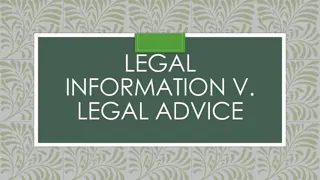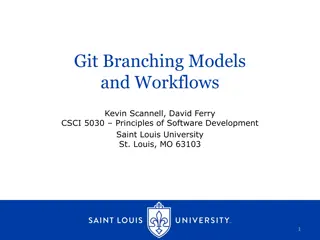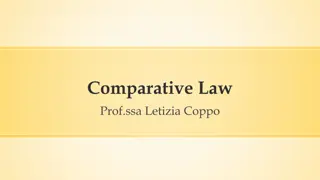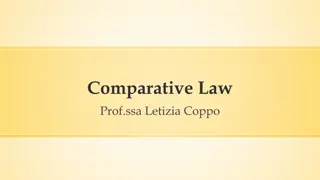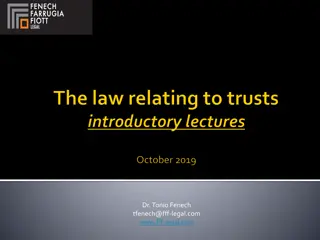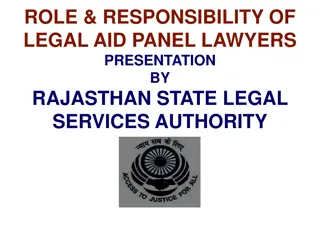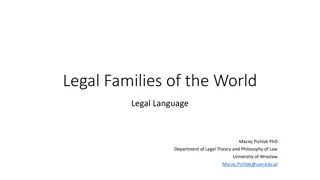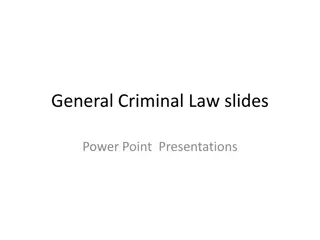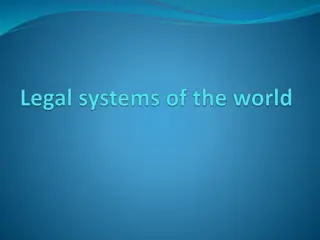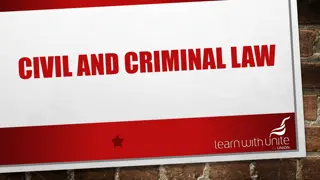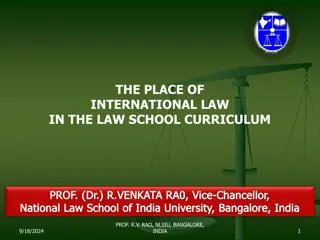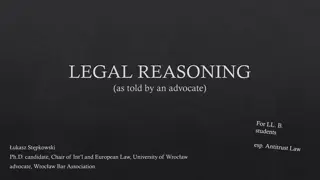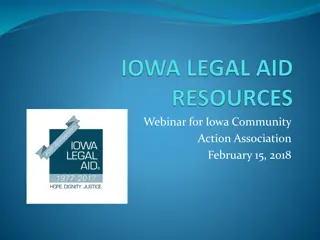Overview of Legal System and Branches of Law
This content provides an overview of various aspects of the legal system, including the concept of legal systems, municipal law, international law, public vs. private law, and different branches of law such as public law, private law, and criminal law. It delves into the relationships between individuals, states, and organizations within the legal framework.
Download Presentation

Please find below an Image/Link to download the presentation.
The content on the website is provided AS IS for your information and personal use only. It may not be sold, licensed, or shared on other websites without obtaining consent from the author.If you encounter any issues during the download, it is possible that the publisher has removed the file from their server.
You are allowed to download the files provided on this website for personal or commercial use, subject to the condition that they are used lawfully. All files are the property of their respective owners.
The content on the website is provided AS IS for your information and personal use only. It may not be sold, licensed, or shared on other websites without obtaining consent from the author.
E N D
Presentation Transcript
The Legal System Legal Language Maciej Pichlak PhD Department of Legal Theory and Philosophy of Law University of Wroclaw Maciej.Pichlak@uwr.edu.pl
The concept of legal system The concept of legal system SYSTEM: collection of elements internally organized Legal system is a system of binding legal norms, which are organized according to formal and material relations between them. Legal system and system of sources of law
MUNICIPAL LAW DOMESTIC or NATIONAL LAW LOCAL LAW
International law - Public international law relations between sovereign states - Supranational law states and private individuals; limitation of state s sovereignity by supranational jurisdiction (EU; ICC) - Quasi-legal systems of private organizations (FIFA) - Private international law (conflict of laws)
Laws in legal system PRIVATE PUBLIC [ criminal] SUBSTANTIVE PROCEDURAL CONSTITUTIVE
Public vs. private law Public law governs the relationships between individuals and the state. It governs the exercise of powers of the government and public authorities. Private law governs relationships between private entities: citizens, families, or corporate bodies. It governs their rights and duties in mutual relations.
Public Public vs. private law: Mr. Mustafi and the Town Hall Private
Public Public vs. private law: Mr. Mustafi and the Town Hall Private
Branches of law PUBLIC LAW PRIVATE LAW CRIMINAL LAW Constitutional law Administrative law Civil law [Family law] Criminal law substantive Law of commerce [Tort law] Fiscal law Tax crime law [Law of succession] Labour law Law of administrative proceeding procedural Law of civil proceeding Law of criminal proceeding PUBLIC INTERNATIONAL LAW SUPRANATIONAL LAW
Types of relation Formal relation (competence) Material relation (content) Formal + material H I E R A R C H Y material BRANCHES
Hierarchy Formal relation of competence Material relation of content in a strong sense in a weak sense Consequences: lex superior derogat legi inferiori
Conflicts of rules Situation when two norms cannot be both applied. CONFLICT LOGICAL AXIOLOGICAL PRAXEOLOGICAL contrariety contradiction
Logical collision On the level of linguistic meaning of norms. CONTRARIETY: (partially) equal hypothesis and different dispositions. One may break both of them. CONTRADICTION: While breaking the first, one acts in compliance with the second one.
Praxeological conflict On the level of the practice of implementing norms. E.g. contradictory goals that norms serve. With this kind of collision, it's sometimes possible to implement both norms. Still: - implementing one norm may make implemetation of another one much more difficult; - implementing of the second norm eliminates the effects of implementation of the first one.
Axiological conflict On the level of values the norms serve. Contradiction between two values. Similarly to the situation of praxeological conflict, both norms may often be implemented but only to some extent.
Collision rules (rules of conflict of rules) Lex superior derogat legi inferiori Lex posterior derogat legi priori Lex specialis derogat legi generali A problem of meta-rule Problem of applying the hierarchical rule: different situations of administrative agency and various types of courts. Lex inferior non derogat legi superiori?
Article 148. 1. Whoever kills a human being shall be subject to the penalty of the deprivation of liberty for a minimum term of 8 years, the penalty of deprivation of liberty for 25 years or the penalty of deprivation of liberty for life . 2. Whoever kills a human being: 1) with particular cruelty, 2) in connection with hostage taking, rape or robbery, 3) for motives deserving particular reprobation, 4) with the use of firearms or explosives shall be subject to the penalty of the deprivation of liberty for a minimum term of 12 years, the penalty of deprivation of liberty for 25 years or the penalty of deprivation of liberty for life . 3. Whoever kills more than one person in one act or has earlier been validly and finally convicted for homicide shall be also subject to the penalty specified in 2. 4. Whoever kills a person due to the influence of an intense emotion justified by the circumstances shall be subject to the penalty of the deprivation of liberty for a term of between 1 and 10 years.
Further reading 1. BASIC: 1. 2. ITL, Chapter 7 Bussiness Law Basics, Chapter 4, http://www.businesslawbasics.com/chapter-4-classifications-law-0 2. ADDITIONAL: 1. International Law and Municipal Law, in: Encyclopaedia Britannica, https://www.britannica.com/topic/international-law/International-law- and-municipal-law 2. R. Michaels, J. Pauwelyn, Conflict of Norms or Conflict of Laws?, http://scholarship.law.duke.edu/cgi/viewcontent.cgi?article=2933&context =faculty_scholarship




